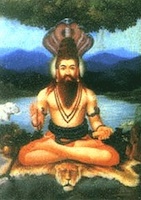Yoga & Meditation
According to the Vedas, the meaning of the word Yoga is “Union”. However when people speak about Yoga nowadays, they use the term often simply as a replacement for body postures (Asanas) or breathing techniques (Pranayamas) which is not the complete perception of Yoga.
Types of Yoga
Yoga means Union. But Union of what?
The process of “Union” is only possible in the presence of two or more entities. So it is only natural that there are different Types of Unions, for example:
- Hatha Yoga: Here the Yoga is the “Union of Kundalini (- charge) with Siva (+ charge)”.
- Bhakti Yoga: This Yoga stands for the “Union of the Devotee with God”.
- Gnana Yoga: This Yoga means the “Union of Self with Wisdom”.
In ancient times, Yoga was divided into 33 types based on the elements which participate in the process of “Union”. These 33 Yogas again can be categorized into physical, mental and spiritual channels depending on the effects their practises have in the different levels.
For example in the physical level, Asanas and a good diet are used to attain a healthy physical body. The practise of “Chakra Bhedana” (activation and enlightening of Chakras) and self discipline are used to solve psychological imbalances and weaknesses and are related to mental level. Practises such as “Atma Vicharana” (self analysis) and “Aatma Sakshatkara” (Soul realisation) and other practises which operate beyond the mind are related to spiritual level.

Asthanga Yoga – Eight Limbs of Yoga
The complete perception of Yoga
In order to understand the relation between Yoga and Meditation, we will look at the complete perception of Yoga according to Patanjali.
Yoga is not only physical exercise, stretching, breathing exercises or meditation but all of these and more.
There are eight limbs or principles in Yoga which are as follows:
- Yama – Moral principles related to society. So if somebody lives a successful and harmonious life in society, he is also practising one part of Yoga.
- Niyama – Personal principles, such as what to eat, when to eat, when to sleep and so on.
- Asana – Body postures to enhance the energy flow in meridians by applying proper pressure on different parts of the body (using the principles of reflexology).
- Pranayama – Breathing exercises to regulate mind and energy.
- Pratyahara – Controlling the mind from its deviation to the external world through the five senses Sight, Hearing, Touch, Smell and Taste.
- Dharana – Concentrating internally (here “Meditation” starts).
- Dhyana – Observing the changes occurring during Dharana.
- Samadhi – Thoughtless state which is beyond the mind.
Yama, Niyama and Asanas are in physical level. Pranayama and Pratyahara are in mind level. Dharana, Dhyana and Samadhi are beyond the mind.
This is the complete perception of Yoga.
The main Aim of Yoga
Meditation is a part of Yoga, but what is the main aim of Yoga itself?
Yoga, which is independent of a particular faith or religion, aims to restore the harmony between Matter, Energy and Mind. One of the reasons for suffering from different types of disorders, be they physical or psychological, is the inharmony among Body, Energy and Mind.
By doing the Heart Soul Meditation, one can restore this harmony in three levels: One can attain personal harmony by balancing the physical and subtle bodies. By passing the Heart Soul Energy through the physical body cells to the universe, one can restore the harmony with the universe. Thus by practicing Heart Soul Meditation, one can establish harmony personally as well as universally. This is an ultimate aim of Yoga.
There are many positive claims for Meditation such as improved physical health and stability of the mind for instance, but while we meditate, we are just “sitting” – we are not taking any physical medicine (like herbs) as we normally would to cure a headache for example. So how does it actually work?
This we will see in the next topic “The Complete Human Being”.